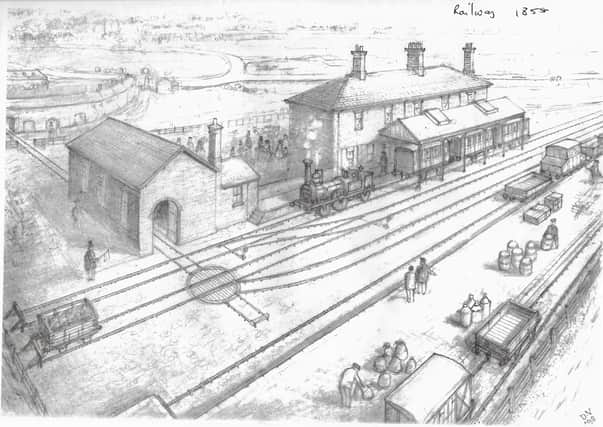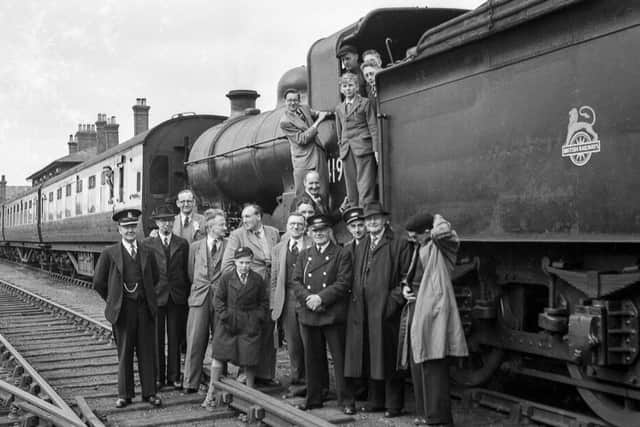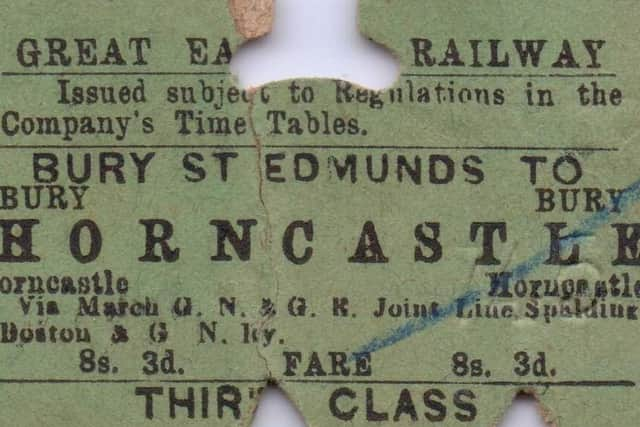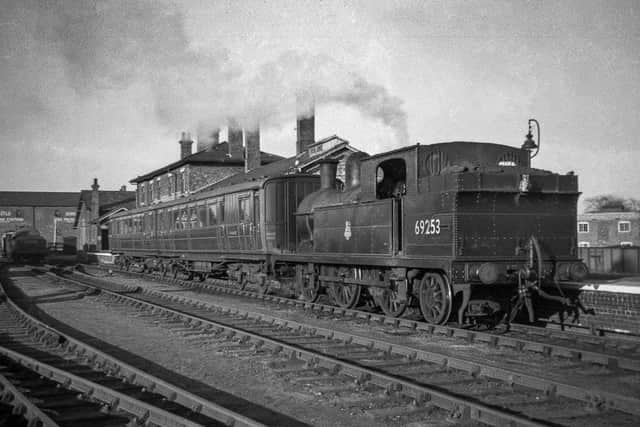A celebration of Horncastle’s once proud railway


The date was Easter Monday, April 5, 1971.
To mark this significant anniversary in the district’s history, a virtual exhibition is to be staged by the Horncastle History and Heritage Society on their website at www.HorncastleJBC.info/railway.
From March 31, it will tell the story of the line’s construction, operation, the fight to keep it open and what happened after closure.


The exhibition will also ask the question...What if?
Advertisement
Hide AdAdvertisement
Hide AdWhat would Horncastle have looked like and how would it have developed if the railway had survived?
Would there be less congestion and pollution on the roads?
Would travel to London (from where a through railway carriage once ran daily to Woodhall Spa and Horncastle), to Boston, Lincoln and Skegness, have been faster and easier?


Or, could it have become a heritage railway, attracting tourists to boost the local economy?
The History and Heritage Society has been planning the event for several months.
Advertisement
Hide AdAdvertisement
Hide AdIt will feature some remarkable exhibits – including a colour drawing of Horncastle Station, discovered after being tucked behind someone’s wardrobe for the last century!
There’s also one local, lingering ‘mystery’ that could be solved.


For many years, older residents have believed there was a train buried close to what is now Bell’s Yard.
However, the society believes it’s more likely to be skip wagons used to transport clay for making bricks.
Advertisement
Hide AdAdvertisement
Hide AdSociety chairman, Dr Ian Marshman, said: “What has emerged already is the huge interest in Horncastle’s railway – in the town and further afield.
“People have shown us relics like old railway signs salvaged from the station yard, rare posters and tickets.
“We have also tracked down a long-lost hand drawn plan in beautiful colour for Horncastle Station, which was preserved by being hidden behind a wardrobe for over a century.
“There are also some never-before-seen photographs of the station, and the people who lived and worked around it, that have come to light.”
Advertisement
Hide AdAdvertisement
Hide AdAn expert on rare train tickets has offered to display his collection of colourful Horncastle and Woodhall Spa train tickets, which date from the late 1800s and early 1900s.
Dr Marshman added: “Another question we’ve puzzled over, is why was there a pub in Horncastle called the Railway Hotel on North Street, far away from the station.
“We’ve been told that older people in the area believed that ‘a train’ was buried at the bottom of the old brick pits nearby, in what is now called Bell’s Yard.
“We think it could have been skip wagons used to move clay for the bricks, as much equipment was washed into the pit during a major flood in the 1920s.
“However, for now, the truth remains a mystery”.
Advertisement
Hide AdAdvertisement
Hide AdAs for the last train to leave Horncastle, it was a freight train, bound for Lincoln via Woodhall Spa, Woodhall Junction, Stixwould, Southrey and Bardney, where trains had continued to serve the sugar beet factory.
For Horncastle and Woodhall Spa, it really was the end of the line for a service that had begun in 1855.
Long before that final train, daily passenger trains had ceased, despite huge local opposition, on September 13, 1954.
A special train organised by enthusiasts ran 10 years later, bringing the largest steam locomotive ever seen in Horncastle to the branch...but after that, only goods trains.
Advertisement
Hide AdAdvertisement
Hide AdIn those later years, the train crews had to open and close level crossing gates and change the points on the seven-and-a-half mile run from Woodhall Junction.
In its heyday, the line was very profitable and the original Horncastle and Kirkstead Junction Railway paid good dividends to shareholders under an agreement with the operator, the Great Northern Railway, until absorption into the London & North Eastern Railway in 1923, which was later nationalised in 1948.
Apart from the online exhibition, it is also hoped to stage a ‘physical’ exhibition at the re-launched Sir Joseph Banks Centre in Horncastle in the summer, once Covid-19 restrictions are eased.
This will be a chance to display photos, objects and mementos of the railway, and perhaps even a model of the town’s lost station.
Advertisement
Hide AdAdvertisement
Hide AdThe society has also worked with Lincolnshire County Council to design a new leaflet for the Spa Trail which follows the route of the old railway.
It is hoped this will help encourage more visitors to walk and cycle to Horncastle and Woodhall Spa, once tourists are allowed to return.
At the other end of the Horncastle branch line, the award-winning Woodhall Spa Cottage Museum, which is situated next to the old track (now part of the Spa Trail), is also planning to mark the anniversary.
Four information boards on the history of the line and the significant role it played in developing Woodhall Spa (which enabled Queen Alexandra to travel directly from London to ‘take the waters’) have been produced for a special display.
Advertisement
Hide AdAdvertisement
Hide AdThe display has been put together with the assistance of the current owners of the former Woodhall Junction station, which is now a private residence.
An original director’s report from 1863 has been located and the museum has a number of relics and photographs of the line which it’s hoped visitors will be able to see, when the easing of covid restrictions enables it to reopen.
One item the society would love to get their hands on is a lost model of Horncastle Station, which has not been seen since the closure of the town’s museum in 2002.
At first, it was thought the model had been transferred to the Museum of Lincolnshire Life, but they don’t have it.
Advertisement
Hide AdAdvertisement
Hide AdThe magazine Heritage Railway (published in Horncastle) and the website Rail Advent have both published appeals for information on its whereabouts after local appeals failed to locate it – though they did bring to light other relics of the original line,
The appeal has also been shared by the Midlands Region of Historic England on their Twitter feed and by the Great Northern Railway Society.
The full size station was opened to passengers on August 11, 1855. Local services ran to Woodhall Junction and to Boston, with onward connections.
The owners and builders were the Horncastle and Kirkstead Junction Railway Co. Ltd, formed by local citizens, but it was always operated (profitably) by the Great Northern Railway until the grouping of the railways in 1923.
Advertisement
Hide AdAdvertisement
Hide AdThe initial appeal for information led to the discovery of a photograph of the model once exhibited in the museum.
It had been built by a solicitor in Horncastle, Col. Reggie Tweed, whose family had been involved in the formation of the original Horncastle Railway Company which built the branch line to the town.
The model was complete with a model locomotive and carriages. It was, not surprisingly, very popular with visitors.
One member of the historical society said he recalled it being stored at a private house in the town and that before the museum’s closure: “it looked pretty dilapidated”.
Advertisement
Hide AdAdvertisement
Hide AdDr Marshman said: “The big question now is: Where is it? We would like to return it to Horncastle to display in the town and perhaps offer to the Woodhall Spa Cottage Museum, with who we’re working on anniversary commemorations”.
Suggestions that the model may have gone to a railway museum at Burgh-le-Marsh have also been discounted.
• If you have any information about the lost model - or any aspect of Horncastle’s railway history - please contact Dr Marshman on 01507 523526 or email [email protected].